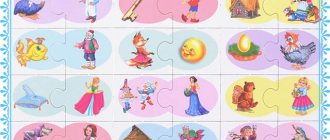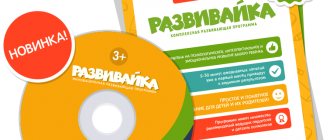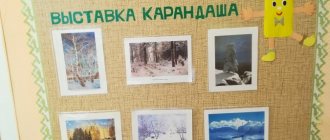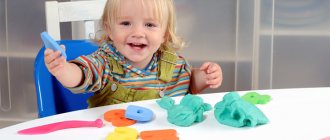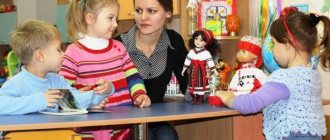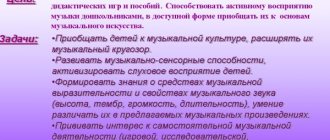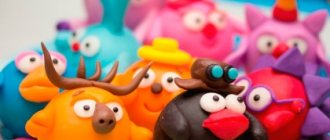Organization of theatrical activities with young children (Analytical report)
Municipal preschool educational budgetary institution
"Murino combined kindergarten No. 4"
(MDOBU “Murinsky DSKV No. 4”)
Analytical information
Organization of theatrical activities with young children
2 junior group No. 1
«
Gnomes"
Prepared by teacher: Solyanova Yu.P.
2020
Theatrical activities in kindergarten according to the Federal State Educational Standard
“ Theater is a magical world.
He gives lessons in beauty, morality and ethics. And the richer they are, the more successful the development of the spiritual world of children..." (B. M. Teplov)
In a preschool educational institution, theatrical activities are one of the most accessible forms of art for children, it gives the child the opportunity to satisfy his any desires and interests, to get acquainted with the environment the world in all its diversity, to activate the vocabulary and sound culture of speech. Theatrical activities are an inexhaustible source of development of the child’s feelings, experiences and emotional discoveries.
It is known that children love to play; they should not be forced to do so. While playing, we communicate with children on “their territory.” By entering the world of play, we can learn a lot ourselves and teach our children. And the words spoken by the German psychologist Karl Gross are relevant in this regard: “We play not because we are children, but childhood itself is given to us so that we can play.”
We know that getting to know the theater takes place in an atmosphere of magic, festivity, and high spirits, so it is not difficult to interest children in the theater.
In the context of the transition to the Federal State Educational Standard for Preschool Education, one of the main principles of preschool education, reflected in the Standard: “Implementation of the Program in forms specific to children of this age group, primarily in the form of play, cognitive and research activities, in the form of creative activity that ensures artistic and aesthetic child development".
Theatrical activities in kindergarten are an excellent opportunity to reveal the creative potential of a child and foster the creative orientation of the individual.
The content of work with children on theatrical activities in preschool educational institutions is organized as follows
- Diction exercises (articulation gymnastics);
- Tasks for the development of speech intonation expressiveness;
- Transformation games, imaginative exercises;
- Exercises for the development of children's plasticity;
- Rhythmic minutes;
- Finger play training;
- Exercises to develop expressive facial expressions, elements of pantomime;
- Theater sketches;
- Acting out mini-dialogues, nursery rhymes, songs, poems;
- Watching puppet shows.
Using theatrical activities in the system of educating children in preschool educational institutions, we try to solve a complex of interrelated problems in all educational areas according to the Federal State Educational Standard for Preschool Education.
Social and communicative development
• formation of positive relationships between children in the process of joint activities;
• fostering a culture of learning in adults and children (emotional states, personal qualities, assessment of actions, etc.);
instilling in the child self-respect and a conscious attitude towards his activities;
• development of emotions;
• education of ethically valuable ways of communication in accordance with the norms and rules of life in society.
Cognitive development
• development of diverse ideas about reality (different types of theater, professions of people creating the performance);
• observation of natural phenomena, animal behavior (to be conveyed by symbolic means in a dramatization game);
• ensuring the relationship between construction and theatrical play for the development of dynamic spatial concepts;
• memory development, learning the ability to plan your actions to achieve results.
Speech development
• promoting the development of monologue and dialogic speech;
• enrichment of the vocabulary: figurative expressions, comparisons, epithets, synonyms, antonyms, etc.;
• mastering expressive means of communication: verbal (regulation of tempo, volume, pronunciation, intonation, etc.) and non-verbal (facial expressions, pantomime, postures, gestures);
Artistic and aesthetic development
• introduction to highly artistic literature, music, folklore;
• development of imagination;
• involvement in joint design activities on modeling costume elements, scenery, attributes;
• creation of an expressive artistic image;
• formation of elementary ideas about types of art;
• implementation of independent creative activities of children.
Physical development
• coordination of actions and accompanying speech;
• the ability to embody the mood, character and process of image development in a creative movement;
• expressiveness of execution of basic types of movements;
• development of general and fine motor skills: coordination of movements, fine motor skills of the hand, relief of muscle tension, formation of correct posture.
In our work with children, we use various techniques: diction exercises (articulation gymnastics); tasks for the development of speech intonation expressiveness; transformation games, imaginative exercises; exercises for the development of children's plasticity; rhythmic minutes; finger play training; exercises for the development of expressive facial expressions, elements of pantomime; theatrical sketches; acting out mini-dialogues, nursery rhymes, songs, poems; watching puppet shows.
To identify the interests of children in groups, exhibitions of books with fairy tales were held, and a quiz “Visiting a Fairy Tale” was held.
To organize a children's theater, we need puppets of various systems that develop in children certain skills and abilities, stimulate children's creativity (singing, dancing, playing), encouraging improvisation on children's musical instruments. I filled up theater corners in groups. Of all the types of puppet theater in kindergarten, the most popular is the theater of pictures and bi-ba-bo dolls.
Types of theatrical activities
According to the requirements of the Federal State Educational Standard (FSES), 6 types of theatrical games are used in kindergartens.
Theater on the stand
The essence of a stand theater is that scenery and character figures are attached to a certain surface. Stand games include:
—
flannelograph
- a board on which fabric is stretched, with the figures usually attached with Velcro, and the child or teacher moves them as the plot develops (there may be one board itself, but there may be several sets for fairy tales);
Target
: develop children's creative abilities through
theatrical activities .
Tasks
: - consistent introduction of children to types of
theater ( flannelograph )
;
- improvement of artistic skills;
- work on speech and intonation; — collective interaction;
- the ability to sympathize and empathize.
—
magnetic
(identical to flannelgraph, only the magnetic board acts as the base)
Target
: Creation of a social development situation in the process of preparation and implementation of the production of “Magnetic Theater - Teremok”
Tasks
: Create conditions for the formation of ideas about the theater.
Provide conditions for choosing a role, method of action, partners, activities.
Create conditions for the development of speech activity: development of dialogic speech.
To promote a respectful attitude towards people’s work.
Theater on the table
The dramatization takes place on a table, so the characters and scenery are small. Such a theater could be:
- paper (or cardboard) - characters and necessary attributes are cut out according to templates;
- from natural materials (for example, characters made of cones, chestnuts or acorns are placed in a sand box).
- puppet theater on the table
Fairy tale "Turnip" Fairy tale "Kolobok"
Fairy tale "Wolf and seven little goats"
Wrist and finger theater
The plots are played out with the help of dolls, which are worn separately on each finger or in the form of a glove over the entire palm. The peculiarity of this type of theatrical activity is that the characters of the finger theater are made from scrap materials, for example, from:
- cardboard cut in the shape of a cone;
- fabrics;
- tennis balls;
- eggs from Kindersurprise;
- plastic bottles, plates, glasses;
- With
packing boxes, etc.
Goal: To teach children to perceive and understand the figurative content of a fairy tale, to invent new episodes; teach to understand the character of heroes; help relieve mental stress. Develop correct, emotionally rich speech.
Tasks:
develops fine motor skills of the hands (after all, when choosing the order of characters to appear on stage and at many other moments of the production, precise, coordinated work of the fingers is needed);
- trying not to miss the “output” of his character, the baby develops the ability to concentrate;
- by memorizing the characters' lines and trying not to confuse them during the performance, the child trains his memory;
- theatrical performances develop fantasy and imagination, especially when it comes to improvisational scenes;
- The vocabulary is enriched, the construction of sentences becomes more correct and detailed;
- in the process of moving characters around the stage, spatial thinking develops (such important concepts as “left” and “right”, down and up, previous and next are practiced in a playful, unobtrusive form), as well as for getting to know and studying counting (for example, in the fairy tale “Teremok” “The mouse, the frog, the hare began to live together, then the fox came - there were four of them);
- the opportunity to express oneself on stage develops artistic and creative abilities
- speaking in front of an audience, the child gains self-confidence and becomes more sociable
Horse Theater
This is interesting. The term, denoting a type of theatrical activity in which puppets are fixed above human height, was introduced by Russian puppeteers in the 16th century.
There are several types of horse theater:
- cane (the doll is attached to a high cane);
- b
ibabo (the principle of glove theater, the only difference is that the character acts from behind a screen);
T
theater "Bibabo"
Target:
develop children's creative speech activity.
Objectives
:
Educational :
exercise in lexical formatting of statements;
intensify the use in speech of words used in fairy tales; practice grammatical formatting of statements and the use of direct speech; create conditions for the sensorimotor level of speech; develop articulatory motor skills; intonation expressiveness of speech; consolidate skills in programming narrative statements; practice collective composing of a creative statement. Developmental :
develop conscious speech activity when composing creative statements;
speech and mental operations; auditory perception. Educational:
to develop the ability to work in a team: negotiate, distribute roles, act together, focus on a partner.
Masque
Mask
(translated from Arabic as jester) is a face covering with cutouts for the eyes, nose and mouth, worn for the purpose of role-playing, maintaining one’s incognito, or as a talisman.
Tasks:
- Fostering positive moral ideals, the desire to be responsive, and correctly evaluate the actions of characters.
- Develop a sustainable interest in theatrical play activities.
- To achieve free expression of children's emotions in gestures, facial expressions, movement, singing, and words.
- To achieve children's performing skills in creating an artistic image, using play, song, and dance creativity for this.
- Expand children's ideas about the surrounding reality, about the past and future, about objects, customs and life, nature, etc.
- Let children consolidate their understanding of various types of theater - dramatization, floor theater, table theater.
- Enrich children's speech, achieve correct intonation and expressive speech.
- Encourage children to improvise on familiar fairy tales, stories, and come up with stories of their own.
- Develop memory, thinking, imagination, attention of children.
- Teach children to correctly evaluate themselves and their comrades.
- Induce in children a desire to move, that is, to dance, and create a bright and flexible image.
- To cultivate children’s desire to “play,” that is, to act out fairy tales.
- Achieve the ability to use song, dance and game improvisations in independent activities.
Role-playing theater
For performances we use elements of theatrical costumes: a scarf and sundress for the grandmother, a shirt for the grandfather, a yellow hat for the kolobok, etc.
Target
: Introduce children to the profession of an artist; to develop interest in theatrical play.
Tasks
: Promote the development of dialogical speech; To contribute to the development of children’s ability to reflect game actions and imitate the actions of characters, to convey simple emotional states of characters, using means of expressiveness - facial expressions, gestures, movements; Develop the ability to coordinate actions with other children - the heroes of the fairy tale; Replenish children's vocabulary: poster, theater, performance, actors, spectators, applause;
Cultivate friendly relationships and goodwill.
Group of visual techniques
In preschoolers, visual-figurative perception of the world predominates, so it is impossible to do without visualization in work.
Images
Without illustrations and photographs, it is impossible to explain the concept of theater to children. Therefore, in the theater corner in the group there should be pictures depicting:
- different types of theater;
- costumes, wigs, false mustaches, ears, nose, etc.
Pictures can be organized into booklets - folding books with the plot of a story for production, or lapbooks - folders in which
